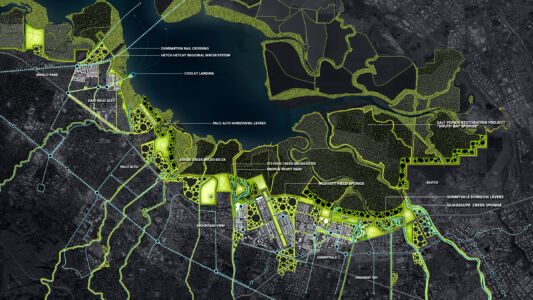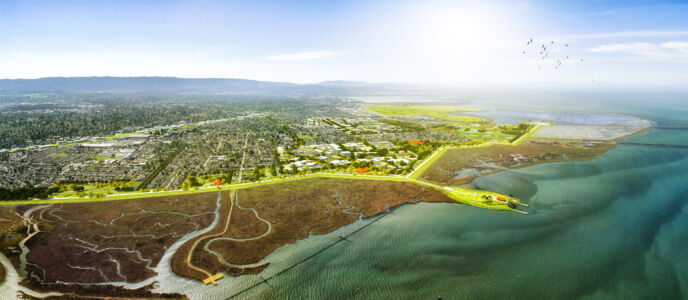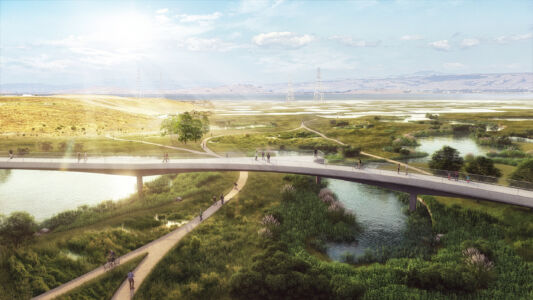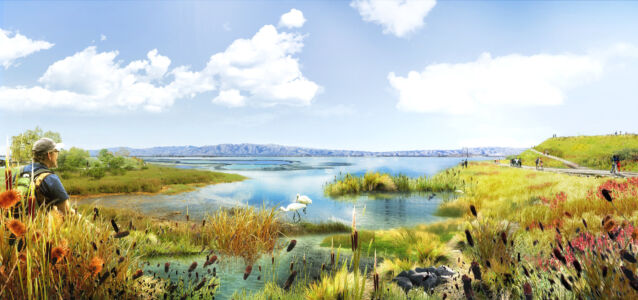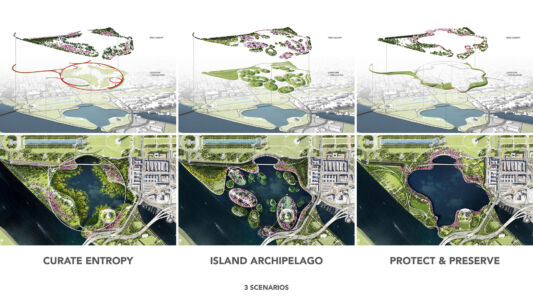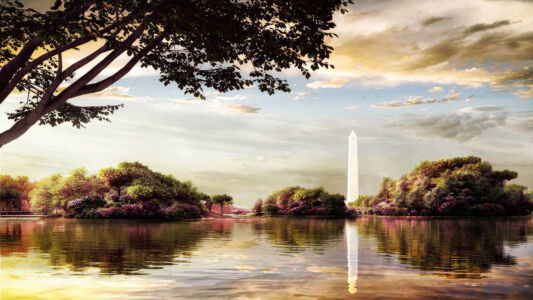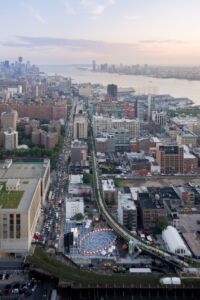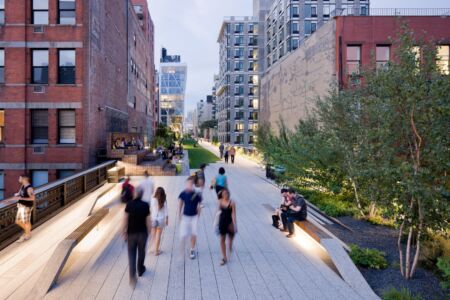“In 2020, beautiful design is not sufficient. We need to do more, we need to go further – looking for our projects to play larger transformational roles: ecologically, environmentally, socially, culturally and politically”. James Corner, one of the main protagonists of contemporary landscape architecture, closed the Landscape Of[f] Limits POLIMI workshop series of lectures. His talk with Sara Protasoni (workshop’s director and coordinator of the Master of Science in Sustainable Architecture and Landscape Design at Politecnico di Milano) and Valerio Morabito (professor in the School and Corner’s colleague at the University of Pennsylvania) was a special occasion to discuss deeply topics the didactic initiative (supported by Il Giornale dell’Architettura as media partner) focused. James Corner’s lecture (as well as other events and materials produced by the LOL workshop) can be seen and downloaded at landscapeofflimits.com.
James Corner (born in 1961 in the United Kingdom; portrayed in the cover picture © PEDEN+MUNK) is Founder and CEO of James Corner Field Operations, based in New York City, San Francisco, Philadelphia, London and Shenzhen. He has devoted the past 30 years to advancing the field of landscape architecture and urbanism, primarily through his leadership on high-visibility, complex urban projects around the world, as well as through teaching, public speaking and writing. Important urban public realm projects include New York’s highly-acclaimed High Line; Chicago’s Navy Pier; Seattle’s Central Waterfront; London’s South Park at Queen Elizabeth Olympic Park; Hong Kong’s Victoria Dockside; and Shenzhen’s new city of Qianhai, a new coastal city for 3 million people. James Corner is emeritus Professor of Landscape Architecture and Urbanism at the University of Pennsylvania School of Design. He serves on the Board of the Urban Design Forum and the Government Advisory Board of Shenzhen.
You have titled your lecture 2020 Repositioning. What is the message?
2020 has brought so many challenges to the foreground of human civilization around the world, from climate change and extreme weather events, to social and racial unrest, to economic inequities in society, to the Covid-19 Pandemic, to global politics and cultural shifts. 2020 is truly annus horribilis! And, as such, as landscape architects and urbanists, we need to re-position our work, going beyond beautification and the design of social spaces, to work more with climate, environment, ecology, communities, identity politics and social inclusion. We need to rethink how we work, how we do big and complex large-scale transformative projects, integrating them with an ecological dimension, bringing natural systems into the city, where social justice, equity, diversity and inclusion are foregrounded. Of course, we have done, and are still doing, many important projects, in many countries and cities: they’re intended for both nature and people, letting communities experience nature and new forms of public space, using the poetic of materials as a key factor. I’m very satisfied with them, but I also think we must go much further with how we shape the physical world.
Which is the direction?
What has happened to our various societies around the world over the past 20 years is very inspiring to me. It has been a time of increased freedoms, more open and liberal societies, and of course enormous technological advancements with both communications and media. However, the past few years have begun to show the challenges as these changes have become stressed and broken. There was a particularly important article published in The New York Times a few months ago: How we broke the world, by Thomas Friedman, who argued that “over the past 20 years, we’ve been steadily removing man-made and natural buffers, redundancies, regulations and norms that provide resilience and protection when big systems — be they ecological, geopolitical or financial — get stressed”. This period opens with 9/11 and the World Trade Center attack. Then we had the 2008 global economic recession. Now the current pandemic and the ongoing climatic change issues. We need to remove the obsession with short-term efficiency and growth and start thinking in the direction of complexity and positive transformation that is both robust and resilient. So the scope of our field, landscape architecture, needs to re-think its overall ambitions and re-direct the imagination and design skills to try to address these major challenges, across all scales.
Is the design culture ready to do that?
Re-thinking and re-positioning of what we could be doing as landscape architects means that we have to work on very large projects, at a large scale, as well as maintaining a focus on the smallest details, the smallest experiences. It is both planning and design, science and art, ecology and urbanism, and poetry and prose, all at the same time – a new way of thinking, working and acting in the world. I do believe that design culture has the right tools to do this – designers are creative people who think out-of-the-box; they push for innovation and change; they conceptualize, visualize, construct and shape new worlds. So, yes, we are ready; it is just case of working with even greater efficacy, assuming more responsibility and imagination.
Is landscape architecture an adept tool to win the challenges?
It can be because landscape architecture interacts with the complexity of the world, it’s characterized by an interdisciplinary approach and it uses the poetic of materials and craft. Our projects have to face the aesthetic quality but to deal also with real problems. We have clients, we have communities. So we need to explain – in a sort of political dimension – where challenges and opportunities are. Our designs have to appear as a logical and rational extension of that initial argument. So my word to students is: you must learn how to design, for sure, but you must also learn how to base your design in real-world issues as a means to construct a compelling argument of why your design is relevant and important.
About students, you were the chair of the Landscape Department at the University of Pennsylvania School of Design for many years. The curriculum you organized was very innovative and attractive, mixing ecology and design in a very strategic way. What do you think about the school of Landscape Architecture in the next future? What might you invent for new curricula for creative and imaginative students?
I think that an education and training to become a landscape architect is extraordinarly difficult. There is so much to do! On the one hand, there is the technical and scientific material: learning about natural systems, ecology, horticulture, soils, site planning, site engineering, materials, details, drawing and documentation, new software and media, and so on. And on the other hand is the creative and artistic material: conceptualization, imagination, visualization, seeing through doing, material craft, designing for poetic experience and new insight. This is like two sides of the brain, one analytical and descriptive, and the other artistic and projective. And, at the same time, is the challenge of culture, understanding the history of the field, its many ideas, works and treatises, and from this, the capacity to think critically, to conceptualize and communicate current day directions, relevancies, new possibilities and ideas. So, it is a challenge for any curriculum to cover all these subjects, and yet a good curriculum should be as comprehensive and as rigorous as possible, especially with regard to the synthesis of all the above. Without this fundamental disciplinary range and skill-set, we can not properly or effectively address the earlier mentioned challenges of climate, society, urbanism or identity.
In the images’ overabundance that characterizes our era it’s difficult to orient, mainly for young students. Which are the 3-must-visited projects or sites in the world you would like to suggest for approaching the topics of contemporary landscape architecture?
Yes, direct physical experience through visitation and strolling in person, is always much richer and deeper than looking at images alone. For pure inspiration: New York’s Central Park; the many parks and gardens textured throughout London; the Gardens at Versailles; the gardens at Stourhead, England; and the many historical gardens of Japan. For what is possible today: New York’s High Line and Brooklyn Bridge Park; Barcelona’s public waterfront; Singapore’s Gardens by the Bay and the Changi Jewel; and various river-floodplain parks and urban developments in China. There is so much, both historical and contemporary, and both natural and designed, that it is impossible to limit the examples. Visit as much as you can; open your eyes and your senses – landscape experiences go very deep in the human psyche: they are lasting, enriching and enormously satisfying.
To give this recommendation to the POLIMI students of the workshop, you have chosen to talk about 2 experiences you’re doing in the US. About the first, you’ve started with a very recent image of the San Francisco Golden Bridge surrounded by fires.
San Francisco Bay is a place with significant environmental challenges. It is already seeing the effects of sea-level rise; extreme weather events, including droughts and wildfires; and it is vulnerable to earthquakes and liquefaction (landslides). It is also quite densely built, with significant challenges for transportation, affordable housing and future growth. Many of the poorer communities are sited on particularly vulnerable areas of land around the Bay. In 2019, we engaged with a large visionary project for re-thinking the Bay, and we argued for “more nature,” “more connectivity” and “more community.” We have called it South Bay Sponge because the new landscape works as a massive ecological sponge: it is an absorptive landscape able to absorb the water, creating new lands for new more compact forms of urban development. Nature itself becomes an ecological system, or infrastructure.
The second project is in Washington DC, the Tidal Basin (Tidal Basin Ideas Lab is a landscape protection and enhancement program involving 4 studios, in addition to James Corner Field Operations: DLANDstudio, GGN, Hood Design Studio, Reed Hilderbrand. The projects are visible, from October 21st, in a virtual exhibition at the website tidalbasinideaslab.org). In this case the impressive images you shared in the lecture paint the US main political monuments completely surrounded by the water.
The sea level is rising and rising, and the Potomac River floods more frequently now, and with graeter impact on Washington DC. It has serious consequences, and also financial ones: flooding costs billions of dollars in insurances and repairs. If we don’t act, in 2060 the entire Tidal Basin will be simply a body of water. We’ve designed 3 alternative and diverse scenarios: in the first one – called Curate Entropy – we let nature take over, building a raised ring walk from where people can see what water can do, occupying spaces. In the second scheme, Island Archipelago, we build new islands to protect the lands and to control water. In the third, Protect&Preserve, we keep nature out, the strategy keeps all the flood water in the river channel and so allows out for total preservation of the interior.
Landscape architecture as a reaction to the climatic change impacts. It sounds paradoxical presenting a project that touches the White House, in this months.
Well, I don’t think Donald Trump will support any of our works because he doesn’t want to be informed. As you know, in the US today there’s a strong debate as to whether or not climate change is even real and the politicians on the right are very skeptical about it, largely becasue of their allegiance to the oil and fossil fuel industries. But in our Tidal Basin work the situation is interesting because this is a commission of an independent preservation group that sees the problems of flooding as inevitable and urgent. They want to work on making the politicians more fully aware of the longer term risks and the challenges. For these reasons we have made alternative schemes with different scenarios, to be seen through a series of images and pictures. Imagination and visioning is a good tool for our work in order to communicate efficiently the argument. They’re intended as occasions to see possibilities and maybe to help change people’s minds.
You talked about inevitability, that sounds as a key-word.
In Washington our argument is clear: a swamp landscape is inevitable. The environment we see now in Florida is moving north, as summers and winters become warmer and more humid. In 50 years time, changes in ecologies and in species inhabiting regional environments are inevitable. I know that is not simple to explain this condition to people but nature is changing, it is a very dynamic system, it is not a static situation: some species and communtiies are moving in while others are moving out. Usually landscape architecture is seen as a discipline looking at maintaining the status quo. But today we need a completely different horizon: and landscape architecture works in the direction of absorbing and addressing the inevitability of change.
And so radicality and provocation are good instruments.
Maybe it’s not a question of being radical, I prefer a different adjective: bold. Being bold means being ambitious. We need to encourage young students to think out of the box, to think bigger, to try and push some ideas, innovative and experimental. Because they’re important as a means of seeing just what is possible.
The complexity of the issues involved in large scale transformative projects is also the complexity of the social structures with so many stakeholders to be engaged. Do you think participation is the right approach to deal with this complexity? And how is possible to integrate participation with efficiency of the process?
Public space is ultimately democratic space; it is only right and proper that a local citizenry be engaged in helping to envision and shape the future spaces in the city. People should be asked what the main features and attributes of a project they especially like and value, and which they do not like nor want. Ultimately, they have to be the ones who will use and value the space long after the landscape architect has left. On the other hand, it is important that the designer helps the local citizenry think out-of-the-box, to extend their imagination of what is possible. It is not a simple matter of asking what people want and then simply providing that; it is more a process of helping people think bigger, to reach for higher goals and to imagine alternative possibilities. It is a project, and requires great skill with communication, visioning and genuine conversation.
The changing world you’re describing is experiencing also the COVID pandemic. How does it have to impact our ways to think and to design?
It pushes the necessity, in the cities, to design larger green spaces because they offer possibilities for people to go out and to have access to a sense of openness and exposure to nature. I’m talking about the dimension of spaces because I really think that, despite smaller spaces can be nice, there is a critical limit. Think about London or Paris or New York: they offer to citizens great possibilities because of their network of huge gardens and parks. It’s also a question of investments: large designs can provoke large investments and moves. I guess that the on-going COVID pandemic is making it more urgent than ever before to re-think open space in our cities, to re-think how we bring nature and experiences of nature into the city, and how we deisgn and construct environments that are resilient, flexible, accommodating and generous.
Does it happen all over the world?
We do work in different places, with different ecologies, different climates, different topographies, different materialities, different feelings. And different cultures. But also within the US, to design landscapes in Seattle is different from doing that in New York, because the local cultures are different. It happens in Europe as well, and I know that in Italy you have diverse conditions, from south to north, from the coast-lines from the internal areas. As landscape architects working in many different places around the world, we need to hone our capacity to listen, to be receptive to locality, to local culture and ecology, in order to create meaningful palces rooted in their context. This means spending some time in a place physically, experiencing it, meeting people, having a meal with citizens, understanding who these people are, coming as close as you can, understanding what’s important for them, how they see the world. We never just turn up somewhere with some great design out of thin air. This is arrogant, and leads to meaningless work; you have to build your design concept out of the conception of the place. It’s difficult but we have to do it, definitively and more intensely given the challenging trends of 2020.


